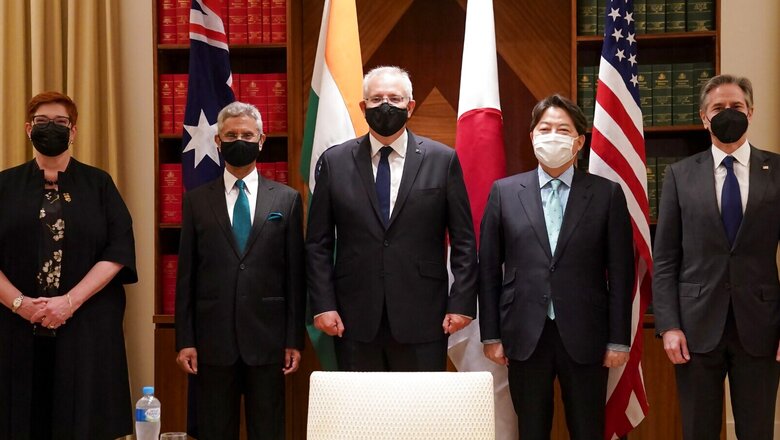
views
So exciting for us in Melbourne (my home) to have hosted the latest Quad meeting, this time of foreign ministers from India, Japan, the US and Australia. But perhaps the ‘cracks’ in this group are showing.
The ‘elephant in the room’ for the Quad is: that while China is the major trading partner of most countries in this region, the US trading involvement locally is not as strong. This raises doubts over the US commitment to the region. Indeed, some say that while Australia was the big loser of the trade war with China, the US did quite well out of it.
This Quad left many questions without answer, and there was little excitement over the outcome of the diplomatic chats.
After all, the next meeting where the leaders of the four countries meet is the big one – this meeting in Melbourne was more about the administrative details of meeting Quad pledges on pandemic vaccines and disaster relief support. This current Quad was more about the detail and less about the vision.
But US Secretary of State Antony Blinken might feel his visit ‘down under’ was worth it when the joint Quad pledged to deepen cooperation to ensure the Indo-Pacific region was free from “coercion”. Now as we all know, so much of the Quad is about China, and this statement was a swipe at China’s growing economic and military expansion.
Here is where the ‘cracks’ really show — Blinken might have pushed India into an uncomfortable corner — despite being outside the group’s scope, an escalating crisis between the West and Russia over Ukraine was also a top agenda item, with US Secretary of State Antony Blinken casting Moscow’s build-up as a challenge to the international rules-based order, which he said Quad would work to preserve.
India maintains close relations with Russia, a long-time friendship, and is unlikely to have shared this US view. Of the four Quad countries, India would be unlikely to upset Russia — it is the only Quad nation with a close relationship with Moscow.
There are also serious regional doubts about the depth of the US commitment to this part of the world – it has long pledged a new Indo-Pacific commitment, but this is still to be seen.
The ‘cracks’ are there over China too, where the Quad does have some divisions, with the US driving strong condemnation, even as India manages to maintain close relations with both Russia and China while being a member of the Quad. It is India that shares borders with China and she, rather than the US, should have much to say to the Quad.
It is constructive to see these countries working on humanitarian relief, terrorism, cyber and maritime security and global supply chain challenges. The Quad agreed to expedite the delivery of COVID-19 vaccines to developing nations in the region, including an additional multimillion-dollar investment from Australia.
It is not clear how serious the Quad is about the US’ push to make an escalating crisis between the West and Russia over Ukraine a top agenda item.
Do Quad members really want to be “championing the rights of all countries to choose their own path, free from coercion” as the US Secretary of State said? Unlikely, as another ‘crack’ in the Quad emerges. While the Biden administration wants to show the world its long-term strategic focus remains Asia-Pacific, members of the Quad might be reluctant to participate in “championing the rights of all countries”.
Asked by reporters on Friday if confrontation with China in the Indo-Pacific was inevitable, Blinken replied “nothing is inevitable”.
It was positive to see the Australian Foreign Minister Marise Payne say the Quad’s cooperation on the region’s COVID response was “most critical”, with cyber and maritime security, infrastructure, climate action and disaster relief — especially after the recent Tonga volcanic eruption — also in focus.
We will have to wait for more details when the May summit of Quad leaders takes place in Japan, with President Joe Biden planning to attend it.
All this shows the Quad is to be taken seriously. But when ‘push comes to shove’, there are questions about how united this group will be. And we still do not know how this Quad grouping will interact with ASEAN – S. Jaishankar, Indian foreign minister, said at the joint press conference after 4th Quad Foreign Ministers’ Meeting: “We will continue to support our ASEAN partners in their efforts to uphold peace, stability and prosperity in the region. Their centrality is important to recognise and reiterate.”
The four countries have made a difference — Quad nations have begun holding annual naval exercises across the Indo-Pacific to demonstrate interoperability, and the United States itself conducts freedom of navigation patrols in the South China Sea. But still in doubt is whether the concept of an “Indo-Pacific Region” is viable or just a construct to push back on China.
For India and Australia, the Indian Ocean remains their biggest opportunity to build a regional body with relevance that can make a difference to this important trading region. This might be the next push if the Quad, an uncomfortable grouping, runs out of steam.
Stephen Manallack is blogger at INTO INDIA, Director of EastWest Advisors and former President of Australia India Business Council. The views expressed in the article are those of the author and do not represent the stand of this publication.
Read all the Latest Opinions here


















Comments
0 comment